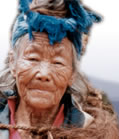 |
 |
||
 |
|||
|
RELATED THEMES culture and customs health identity spiritual beliefs OTHER THEMES IN SW COLLECTION THEMES IN NE COLLECTION BACKGROUND |
traditional skills in the southwest collectionChina's minority peoples are famous for their rich and diverse culture. One very visible expression of this is their highly decorative clothing, both ceremonial and everyday. Each of the groups represented here - Yi, Miao, Lahu, Wa and Yao - have their own colourful and intricate traditional costumes, as well as distinctive headwear, jewellery and hairstyles. Some of the women seem to admire the mass-produced clothing worn by the Han, and certainly appreciate that it can be bought rather than laboriously made, but others say that their own ethnic dress is more suited to their environment, as well as being a source of pride. The skill involved in making and embroidering these clothes is still valued, though it seems it is no longer a requirement for a bride. In the past, "Those who had the whole set of skills of printing and drawing on cloth, spinning and weaving, who were skilful in sewing…" were seen as good marriageable women, says a Lahu woman in her 80s (China 15). Today, sewing is still appreciated but the same narrator confesses, "I don't weave now. One reason is because I have no money to buy the thread - besides, there are many who sell clothes, so you don't have to weave by yourself. Some women still weave cloth. Most of the young people now don't know how to weave cloth. You just have to labour for others for four to five days, then you can buy a piece of clothing to wear." However, the older women who still have sewing and embroidery skills appear to have a useful bartering skill: "People who don't know how to sew go to work. The old people help them sew; they exchange their labour in this way." A Miao woman (China 13) expresses regret for the decline of traditional skills, particularly spinning, saying "it's a pity. We need to do everything. We need to wear our costume when we are invited as guests". Although young people "go to watch TV in the evening" and "don't feel like spinning flax" she accepts that they work hard, helping with household tasks before doing their homework. She intends to teach her daughter the skill once she's left school. And some women definitely mention weaving as one way people can earn money today (China 9 and 10 for example). One young woman (China 14) in particular spends much of her time making Lahu bags and clothes. She is disabled, which means she is better suited to this work than labouring in the fields. There is an interesting exchange (China 18) between a male Oxfam worker and a woman, both Miao. He regards the time spent making Miao traditional clothing as a waste of valuable time and money which could either be put to more economic use - or at least replaced by rest for the already hard-pressed women. "No matter whether they have enough money or not, they all want to make traditional clothes and skirts," he complains. His female interviewer disagrees with his view, making the point that it is precisely because women's lives are "too harsh" and the workload so unrelenting, that they need the solace of a skilled and creative activity that is also a source of pride. A Lahu narrator (China 15) goes into considerable detail about the process of dying cloth, and making different items from it, but she and others do seem to suggest that traditional clothing is worn less and less on an everyday basis. The extent to which women still regularly wear traditional clothing, rather than just for special occasions, may be quite localised, and seems to vary from community to community. Certainly, informal visits to the field by the interviewing team and workshop participants found many of the women dressed in traditional, if clearly very well worn, clothing. Other traditional skills which are mentioned are healing practices, often stemming from spiritual beliefs and customs. One woman suggests that the practice of traditional herbal medicine is confined to men alone: "…the people who know medicinal herbs are all men, not women. Even now I haven't heard about any women in this place who knows about herbal medicine. I'm not sure about the situation in other places" (China 10). quotes about traditional skills"I always think that making these Miao clothes costs too much time… After [a woman] finishes the day's work, she can't go to bed early at night. She has to spin the flax or do something else. Thus her time for rest is short… She is tangled up in those small tasks of making costumes all day long… I think they could make [just] one set to wear in our Miao festivals in remembrance of our tradition." "From morning till evening, all [women] do is work, work, work! …So I think making these clothes allows them to have something to rely on mentally (to put their spirit and thoughts into). It creates a small corner of their own, which belongs to their own private world… [from which] they can gain some kind of psychological satisfaction. Besides, it embodies part of their value system in life. I think if there were no such kind of stuff for them, they would have no support for their souls, and then women's lives would be too harsh, too bitter." "We need to wear our costume when we are invited as guests. We seldom wear it at home. When we go to be the guests, we need to wear the Miao skirts and clothes… We like to wear it. Spinning flax is not easy, young people are lazy, they prefer to buy the ready-made clothes. Sometimes they are too lazy to spin flax, they prefer to buy instead. They work hard [too]. But they also go to watch TV in the evening." "If I couldn't spin flax, couldn't weave… and didn't know how to draw patterns on the skirts, didn't know how to make clothes, I wouldn't be able to get married. So when girls are born and just about [ready] to learn, at the age of seven to eight, parents teach them to do this work: embroidering, flax spinning, sackcloth weaving, and waist-belt weaving… Girls learned it gradually and by the time they were up to the age of 15 to 16, they would be able to finish the whole set of clothes by themselves." "In the past, rich people could buy cotton cloth for wax drawing [patterns]. People who didn't have money would just use sackcloth (made of flax)…Every yarn was spun with effort, after that you had to weave it, then you had to take the cloth to boil it [in order to dye it], and wash it after boiling it… In a complete year you can only make one to two skirts and a few sets of clothes. Now…people have money, they prefer to buy the white [cotton] cloth, do the [pattern] drawing by themselves. This is more convenient… the white cloth is lighter; sackcloth is too heavy." "When the old people sewed, I learned from them… Now the price of thread is very high, and most people wear Han clothes. Han clothes aren't as warm as Lahu ones. The old generation wears only Lahu clothes. Lahu clothes are better than the Han's. If you wear [a Lahu garment] and go to plant rice seedlings, it keeps your knees warm." "Don't you see now the young people's clothes, trousers, all are factory-made? They don't want to wear traditional costume. And like the blankets I'm weaving now; they don't learn to weave these any more. My girl doesn't want to… She said it's too troublesome… If I die, I'll ask them to wrap me in this blanket. I'll leave one for my husband." |
|